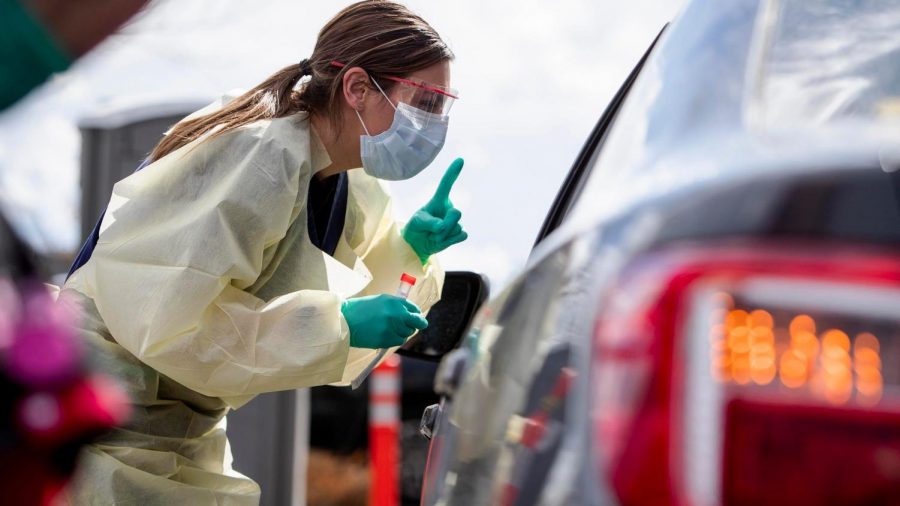Flattening the Curve
Most of us had never heard of social distancing before two weeks ago. Now it’s a way of life.
March 30, 2020
Recently, you may have noticed that everything you have looked forward to, any appointments you had, even your work schedule, has been postponed or outright canceled. What started as a new virus in China has quickly taken over the whole world three short months.
Before a vaccine is developed, it’s likely that authorities will continue to advise social distancing, a term few of had ever heard before this month.
One of the earliest misconceptions about the coronavirus was that it is just like the flu. True, some of the symptoms are similar, but with no known cure and a higher fatality rate — in other words, of the percentage of people who contract each disease, a higher percentage will die from COVID-19. Doctors and researchers around the world have been vigorously working to create a vaccine that will make humans immune to this virus, but that takes anywhere from 12-24 months to go through the right tests and get processed. All we know as of right now is that the best thing that doctors say to do is practice social distancing.
So, why social distancing? The big concern is that the novel coronavirus is extremely contagious. If an infected person simply coughs or sneezes, or touches a surface that a non-infected person touches, that person will most likely now get the virus. COVID-19 is also unique in that, once people are infected, it can take anywhere from 2-14 days for symptoms to appear. This means that the infected person can go out into the public and infect other people with t coronavirus before they even know they have it themselves.
The virus has a different effect on every person it attacks. Some people may only suffer from cold-like symptoms, while others may get a very high fever and other flu symptoms. The virus has a tendency to hit harder of people with pre-existing health problems such as diabetes, heart disease, or asthma. Some cases have gotten so severe to the point of death or people getting put on life support such as a ventilator.
One main way of proof that social distancing works are the study of “flattening the curve”. The curve is the number of people infected over a period of time. If more people are infected over a shorter period of time, then hospitals run out of beds, ventilators, and other materials to treat people. Otherwise, if more people are infected over a longer period of time then hospitals have time to turn over beds, regroup, and get more supplies. The idea of flattening the curve is that people stay at home as much as possible to prevent themselves from getting the virus or even possibly spreading it to other people.
Many of us are now aware of the act of social distancing. Officials around the world are saying that if you have any symptoms of illness then you need to stay home, and if you develop a fever (or any symptom of the coronavirus) you should isolate yourself until you are able to get tested. When in public, you should stand at least six feet apart from the person next to you.
But social distancing may not be enough, according to some authorities. In extreme cases, such as Italy, a lockdown is being enforced, and people are only allowed to leave their houses if it is necessary. Calls for social isolation are gaining traction in countries that worry that they may soon follow Italy’s deadly trajectory.
Social Isolation prohibits work, appointments, school, grocery shopping, or anything that was scheduled. If you add up every person with all of these needs, there will be hardly any social isolation or distancing that takes place.
This act of social isolation is now starting to take effect here in Allegheny County. On Monday the Pennsylvania governor, Tom Wolf, issued a stay-at-home order for ten counties in Pennsylvania, and one is ours, Allegheny. However, enforcement appears to be light at this time. We are not quite on lockdown, but if after two weeks the virus is still prevalent, the order will most likely be strengthened.
In the United States right now, social distancing orders vary from state to state. Here in Pennsylvania, we have a stricter order than in other states. Florida, for instance, currently still has people on its beaches in crowds, yet the state is among the most infected in the United States.
At present, the United States has the most cases of COVID-19 in the whole world, surpassing China, where the disease started. Yet many believe that it could have played out differently. The head of the World Health Organization (WHO), Tedros Adhanom Ghebreyesus, praised South Korea for taking immediate action to stop or slow the infection rate of the virus in South Korea. Once the country saw that the outbreak had reached their country, the government and health officials immediately started testing. Through this effort, they were able to flatten the curve of cases. South Korea, now along with China, is only gaining 50-100 cases every day. The United States, on the other hand, is gaining anywhere from 1o-20 thousand cases every day for the past couple of days.
South Korea has shown the world that it is possible to flatten the curve. Countries like the United States and Italy, who waited to test, are now suffering the consequences of their case numbers skyrocketing. With the cases rising exponentially, many hospitals in the U.S. are running out of equipment, such as masks, gloves, and ventilators. Without the masks and gloves, our health care workers cannot be protected from the virus and could possibly get infected. Without sufficient ventilators, sick patients can die.
The coronavirus so far has not shown us any consistent sign of slowing down in the US, but that does not mean Americans cannot do their part. Stay at home as much as you can, and stay socially distant. This will hopefully stop the virus, and then we can all go back to our normal lives that we know and love.












